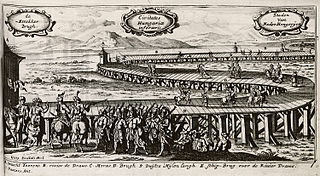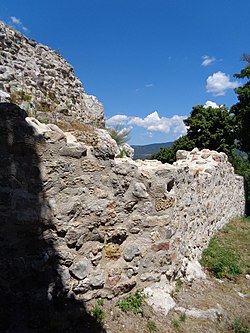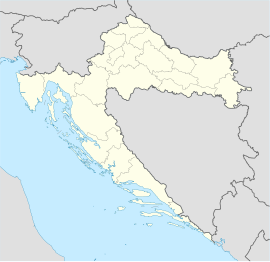
Lika is a traditional region of Croatia proper, roughly bound by the Velebit mountain from the southwest and the Plješevica mountain from the northeast. On the north-west end Lika is bounded by Ogulin-Plaški basin, and on the south-east by the Malovan pass. Today most of the territory of Lika is part of Lika-Senj County. Josipdol, Plaški and Saborsko are part of Karlovac County and Gračac is part of Zadar County.

Udbina is a village and a municipality in historical Krbava, in the Lika region of Croatia. It is administratively a part of the Lika-Senj County.

The 1527 election in Cetin (Croatian: Cetinski / Cetingradski sabor, meaning Parliament on Cetin(grad) or Parliament of Cetin(grad), or Cetinski / Cetingradski izbor) was an assembly of the Croatian Parliament in the Cetin Castle in 1527. It followed a succession crisis in the Kingdom of Hungary caused by the death of Louis II, and which resulted in the Kingdom of Croatia joining the Habsburg monarchy. The charter electing the Habsburg Archduke of Austria Ferdinand I as King of Croatia was confirmed with the seals of six Croatian nobles.

The Battle of Krbava Field was fought between the Ottoman Empire of Bayezid II and an army of the Kingdom of Croatia, at the time in personal union with the Kingdom of Hungary, on 9 September 1493, in the Krbava field, a part of the Lika region in Croatia.
Ivan Karlović, also known as by his Latin name Johannes Torquatus, was the Count of Krbava. His life during critical periods of Hundred Years' Croatian–Ottoman War was marked by constant efforts to stop Ottoman conquests of Croatia, during which he held position of Ban of Croatia twice: from 1521 to 1524 and again from 1527 to 1531. He was also one of the Croatian magnates who participated in 1527 Election in Cetin.

Krbava is a historical region located in Mountainous Croatia and a former Catholic bishopric (1185–1460), precursor of the diocese of Modruš and present Latin titular see.

The fortress of Cetin is situated 5 kilometres (3 mi) south of Cetingrad above the village of Podcetin, in Croatia. The castle and its immediate surrounding represent a monument of great value for Croatian national history because on this place in 1527 Croatian nobility elected Ferdinand I Habsburg a king of Croatia. From that moment on, Croatia remained a part of Habsburg Monarchy until the end of World War I.

Perušić is municipality (općina) in Lika-Senj County, Croatia. The municipality has 2,638 inhabitants, while the settlement itself has 852. The municipality is within the mountainous Lika region of central Croatia. The Kosinj valley region sprawls alongside it.

Marko Mesić was a Croatian priest and war hero from the Ottoman wars. Under his command, Croats and Serbs liberated the region of Lika in the 17th century.

The Hundred Years' Croatian–Ottoman War is the name of a sequence of conflicts, mostly of relatively low intensity, between the Ottoman Empire and the medieval Kingdom of Croatia, and the later Habsburg Kingdom of Croatia. Except for periods of "small" borderland warfare, the conflict also saw episodes of major conquest campaigns of Croatian land undertaken by the Ottomans especially during the 16th century.

Novigrad Castle, locally called "Fortica" is a ruined hilltop castle above village of Novigrad in Zadar County, Croatia.

Bernardin Frankopan (1453–1529) was a Croatian nobleman and diplomat, a member of the influential Frankopan noble family of Croatia. As one of the wealthiest and most distinguished aristocrats in the kingdom in his day, he had one of the leading roles in mounting defences of Croatian statehood against the Ottoman expansion.

The Tržan Castle is a ruined medieval castle above the village of Modruš in the northern part of historical Lika region, central Croatia. Before the administrative seat of the former Modruš County, it is today a ruin in the Josipdol Municipality in the southern part of the Karlovac County.

The Battle of Vrpile or Battle of Vrpile Gulch, also known as the First Battle of Krbava Polje, was fought between the Kingdom of Croatia and the Ottoman Empire in early September 1491 at the Vrpile pass in central Croatia, near Korenica in Krbava. The Croatian army, led by Ban Ladislav of Egervár and Knez (Prince) Bernardin Frankopan, defeated the Ottomans who were on their way back from a raid into Carniola, to the Sanjak of Bosnia, carrying booty and Christian captives to be sold into slavery.

The Gusić family, also known as Gušić, was one of the twelve noble tribes of the Kingdom of Croatia, mentioned in the Pacta conventa. They originated from the hinterland of Biograd in the medieval Luka and Sidraga županijas, where they are recorded at least since the 11th century. Their main regions of influence were Krbava and Gacka, where they often served as župans and knezes at least since the early 13th century. In the 14th century branched Posedarski who seated in Posedarje, and Kurjakovići who as magnates managed to gather much wealth and have high official positions at the Hungarian royal court as well two of their members became Ban of Croatia. As experienced warriors, they actively participated in the Croatian–Ottoman and late Ottoman–Venetian Wars. Direct descendants of the tribe with the surname Gusić, and possibly Gušić, live even today in Croatia and Slovenia.

The Kurjaković family, also known as the Counts of Krbava, were a Croatian noble family that originated from the noble tribe of Gusić. It formed at the end of the 13th century, as descendants of Kurjak. They reached their peak as magnates between mid-14th and mid-15th century, having tight connections and high official positions at the Hungarian royal court, and dissolution in 1531 when the estates of magnate Ivan Karlović went to Nikola III Zrinski. Two members were Ban of Croatia, as well two were founding members of Order of the Dragon.

The Mogorović family was one of the twelve noble tribes of the Kingdom of Croatia, mentioned in the Pacta conventa and Supetar Cartulary. They were initially mentioned in the 12th and 14th centuries in the hinterland of Biograd na Moru and Zadar in Dalmatia, and since the 13th century in the region of Lika, where they branched into most prominently Disislavić noble family, besides being divided into other fourteen noble branches by 15th and 16th century. As experienced warriors, they actively participated in the Croatian–Ottoman wars. Direct descendants of the tribe live even today in Croatia.

Croatian-Slavonian theater in Great Turkish War, concerns military operations undertaken during Great Turkish War of 1684-1689 by the forces of Holy League against the Ottoman Empire on territories of Croatia, Slavonia and Dalmatia. The war was concluded by Treaty of Karlowitz in 1699, which significantly eased off the Ottoman grip off Croatia.

The siege of Sokolac was a siege of Sokolac Castle in Brinje, Kingdom of Croatia, in August 1493, by the joint bans of Croatia John Both de Bajna and Emerik Derenčin, against the Frankopan family, due to the Frankopans' attempt to regain control over the town of Senj. John Both was killed during the siege, and it was eventually abandoned after Derenčin received news of an approaching Ottoman army. The two sides made truce, and fought the Ottomans together at the Battle of Krbava Field the following month.

Cathedral of St. James Senior was a mediaval Roman Catholic church in what was once Krbava. It was consecrated to St. James, the patron saint of former Diocese of Krbava. The information about consecration of Krbava Cathedral to St. James Senior was found by bishop Mile Bogović, while searching the Vatican Archives in 1997.

























